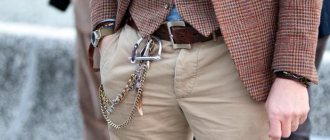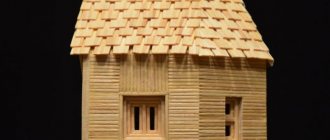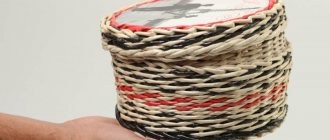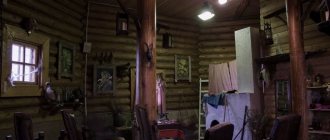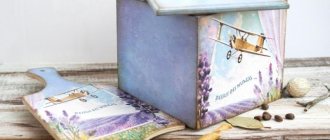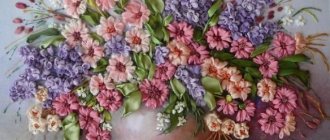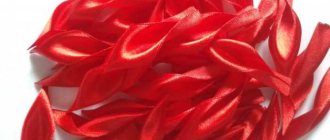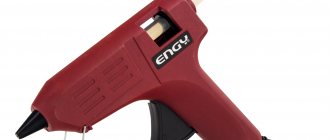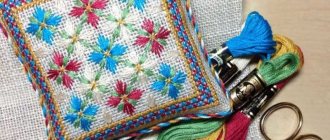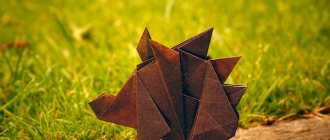Home / Interior furniture / Decor and creativity
3
Reading time: 5 minutes
A
A
Scraps and remnants of various fabrics are not garbage, but a real treasure in the hands of a needlewoman, which can be turned into amazingly beautiful and useful things, for example, rugs for a nursery, hallway or bathroom. There are so many ways to make rugs and rugs that you don’t even need to know how to sew and knit, you just need to choose the most convenient option for yourself.
DIY rugs made from scraps of fabric
After getting acquainted with the methods of making chair covers and sewing rugs, think about whether it is worth throwing away old T-shirts, jeans, towels, woolen sweaters and scarves. After all, all these things, even if they are shabby, with holes, faded in the sun, can be given a second life.
Patchwork fantasies
Bright rainbow rug
- Preparation of flaps Cutting continuous tape
- Connection without node
- Video - Crocheting a round rug from cut fabric strips
- Braid rug
- Video - Denim rugs
General cutting rules
The key to any beautiful thing is its neatness and geometric accuracy. Just like when assembling a mosaic, patchwork requires perfectly calculated and cut pieces that, when combined, will not turn out to be incompatible.
To do this, you need to follow some cutting rules:
- To avoid deformation, change in size and color, after washing a manufactured item, the fabric you just purchased should be washed and then steamed with an iron.
- Before working with previously used pieces of fabric, they should be soaked in a solution of water and starch (it is better to do this with a spray bottle), and then ironed.
- To draw the fabric into scraps of the desired shape, you should use soap or special chalk, or, in extreme cases, a pencil with a soft lead. But under no circumstances should you draw on fabric with a pen: the ink, being absorbed into the fabric, remains there forever.
- Fabrics should be cut in the direction of the grain thread, otherwise the parts may become deformed when sewing. When working with new fabric, you need to focus on the edge.
To cut fabric into elements, you first need to make 2 templates of the desired shape from thick paper or cardboard: one with indents, the second without them. Apply each of the templates to the material one by one and trace it using the above tools.
Knitted rugs from patches
From scraps joined into long ribbons, a rug can be crocheted, just as napkins are crocheted from ordinary yarn. True, for such work you need a large hook, 6-10 mm thick.
Begin work by tying a braid of 5-6 air loops, which are closed into a ring. Then the fabric is knitted in a spiral with double crochets, periodically knitting two stitches from one loop to increase the diameter. After each row, the work must be laid out on a flat surface to control the plane.
Crochet
Crocheting a rug
Video - Crocheting a round rug from cut fabric strips
Such a simple round rug does not require any special skill; even those who have picked up a crochet hook for the first time can knit it. If you have experience, you can create real masterpieces of any form.
Crochet rug
Handmade children's rug
Bright knitted rug
Multicolored rug
Which fabric is best for the job?
Any fabric that is close to the soul of a beginning seamstress can be suitable for patchwork sewing. However, each fabric has its own characteristics and characteristics, which can subsequently affect the ease of use, and, consequently, the quality of the finished product.
Cotton fabric is considered the most popular, since its characteristics allow even novice needlewomen to work with it:
- Optimal density and weight;
- does not shrink when washed;
- when circumcised, it does not crumble or spread;
- does not change color;
- easy to stitch;
- immediately takes the desired shape, which it retains for a long time.
Due to its quality, linen also occupies the top position in the choice of material:
- Durability, wear resistance;
- hypoallergenic;
- high thermal conductivity and breathability characteristics;
- practically does not electrify, even with strong friction.
Patchwork silk products look beautiful and expensive, but they are difficult for beginners.
It is very difficult to work with the material: it is very highly electrified, any mistake made when sewing or cutting will immediately catch your eye. In addition, it is not suitable for creating things for the home (blankets, pillow covers, etc.), as it wears out very quickly and becomes unusable, losing all its luster and beauty.
Today, the trend is warm, homely looks, due to which the popularity of wool products has increased. In addition to the aesthetic function, this material also has a practical one. It’s easier to work with than silk, but you’ll have to get your hand a little used to it first, as problems often arise when stitching.
Among the advantages of this matter are:
- Maintains a neat appearance, as it does not wrinkle;
- resistant to various stains;
- absorbs excess dampness in the house, which does not affect the appearance of the material;
- elastic;
- can last for many years.
One of the advantages of patchwork is that you don’t need to choose only one type of fabric; they can be combined with each other, creating original things.
Preparation of material
In home knitting, weaving, weaving, narrow strips are used, cut from outdated clothes, bedding, unnecessary scraps; any raw material will go into business and find its application. A rug made of knitwear or fine wool will be soft, warm, it is good for a nursery or bedroom, a harder texture is appropriate in the hallway, and a mat that absorbs moisture is more suitable for the bathroom.
Old sheets and towels are convenient; they are easier to cut into strips. First of all, clothes need to be rid of unnecessary details: cut off the top of a T-shirt above the armholes, cut off the belt, pockets, and rough seams from jeans. Wrinkled items must be ironed before processing. The thickness of the future product depends on the width of the cut.
If the tapes are too short, they are connected to each other. It is not recommended to tie with knots, it is inconvenient to work with and looks sloppy. In order for rag rugs to have an aesthetic appearance, the connection must be inconspicuous.
Stitching with a needle takes a lot of time, but there is an excellent technique: cut slits at the places to be joined, lay one on top of the other, thread the end of the strip into the common hole and pull it out.
Patchwork technique and its varieties
This sewing technique has a long, rich history, during which patchwork has acquired new forms and varieties, thanks to which every beginner can choose their favorite sewing patterns using step-by-step instructions and photos.
Traditional version of the patchwork technique
Things in traditional patchwork are made using pieces of fabric shaped like simple geometric shapes with regular silhouettes. In this option, you can make things both small (pillowcase, potholder) and large (blanket, rug).
A distinctive feature of classic patchwork is that the front side consists of patches , while the lining can consist of solid material.
Japanese patchwork
This version of sewing from scraps combines the traditions of the East and West. For the most part, large-sized items are made using this technique. Preference is given to silk fabrics, mostly expensive and of high quality. But to fill the arms, beginners can train on a cheaper variety of silk.
The basis of the elements, as in the traditional version, are geometric shapes:
- squares,
- rectangles,
- diamonds.
Knitted patchwork
This type of patchwork is in many ways similar to the traditional one, however, here the elements are not sewn together, but are connected using a hook.
Moreover, different materials can be used. The most common items used in this type of patchwork are women's bags and bedspreads.
Crazy patchwork
Unlike other types of patchwork, here the elements do not have clear geometrically regular shapes, rather the opposite - hence the name.
Threads in places of stitching are masked by various means: lace, ribbons, embroidery, etc. In addition, the use of beads, seed beads, buttons, and various pendants is common.
Quilt
In this technique, using machine stitching that reproduces various patterns, 2 fabrics are sewn together, between which a soft lining, for example, made of padding polyester, is placed. This type of patchwork attracts craftswomen with greater elegance.
Watercolor technique
The basis of the product in this technique are squares, the colors of which are combined from light to dark. The correct selection of colors and placement of patches creates the effect of painting with watercolors.
For beginners, it is best to choose medium-sized printed fabrics to get a beautiful pattern.
Fabric-based products
You can use fabric as a backing: burlap. Prepare 2 by 10 scraps and get to work. Thread each piece into the cell evenly across the entire width of the base, the tighter the better. This way the rug will be fluffy and soft.
Before creating a rug from old T-shirts turned into yarn, trim the ends of the fabric and select the shape.
This rug is perfect for both the hallway and the bathroom.
“Well” technique
This technique is also based on a square, however, unlike “Aquarium”, where the canvas consists of square patches, here the canvas itself has a square shape, thanks to the strips sewn together, which form a geometric figure. There are two ways to connect strips into a square, which differ in assembly patterns.
This technique is quite simple for beginners, as it has a simple stitching pattern.
And with step-by-step instructions and photos, patchwork sewing using this technique should not cause any difficulties.
Jacob's Ladder technique
This technique is performed from two geometric shapes: a triangle and a square. So, to create a canvas using this technique, you need 9 square-shaped flaps. 5 of them should consist of squares of 2 different colors (i.e. one square consists of 4 square parts), 4 - of 2 triangles, also of different colors.
All elements must be combined as follows: one flap with squares is located in the center, elements with triangles are sewn to each of the 4 sides of the central element, the remaining elements with squares must be placed on empty spaces (ultimately, the flaps sewn together should form a square).
Bargello technique
To make things using this technique, first of all, you need to cut fabrics of different colors into strips of equal length and width, which are then sewn together to form a complete fabric. Next, the fabric needs to be sewn into a “pipe”, which is then cut across the seams so that all strips have the same length and width and consist of different color elements.
The last step is to sew the flaps into a canvas, forming a pattern by “separating the ring” in a certain area, and each time it is different. At first glance, patchwork using this technique may seem too complicated and confusing for beginners, but step-by-step photos and diagrams will dispel these fears.
Basketry
Choose a shape: circle or rectangle. To make rugs with your own hands using weaving technology from old T-shirts, prepare a backing, depending on the chosen shape.
A wicker rug can be made without a hook.
To create a round-shaped product, you will need a circle of paper, the diameter should correspond to the desired size of the work. Divide it into equal segments passing through the center, you can use a ruler. Holes are made at the edges to secure the threads. When the workpiece is ready, start working on the gimp thread. After fixing it, weave in a circle with yarn, above and below the thread. The ends of the yarn are secured from the inside out using a thread and a needle.
Pizza technique
The name of the technique speaks for itself, because it is almost exactly like preparing a national Italian dish.
On the underlying base fabric you need to “scatter” (chaotically, but not forgetting about color compatibility) multi-colored fabric elements (as a rule, they are small in size), which then need to be covered with a transparent fabric. At the end, the “pizza” needs to be stitched so that it does not fall apart.
Boro technique
This technique is as follows: take fabric for the base, and sew various pieces of material onto it, similar to patches on old clothes.
Basically, the fabrics should match the type of material, but you can show your imagination. The most popular fabric for this technique is denim.
Kitchenware
The kitchen is the place where almost anything can be done using fabric scraps, especially if it is a country kitchen. We list the main kitchen items made from scraps:
- potholders,
- tablecloths,
- covers for stools and chairs,
- hot coasters,
- serving napkins,
- aprons,
- organizers for cutlery and kitchen utensils.
And this list can be continued. If you decide to dispose of excess pieces of fabric, then the first thing we advise you to do is go to the kitchen. Your imagination will have room to run wild there.
“Lyapochikha” technique
This is a fairly simple technique in which scraps of the same length are sewn in rows. Each of the elements is stitched in the middle, bending the edges to create the required volume.
In order for the product to keep its shape, the flaps are sewn very tightly. The splendor of the product depends on the length of the elements. The most popular item used using this technique is a rug.
Cake
For sewing you need to take:
- fabric of two types of colors;
- tape;
- button;
- padding polyester;
- threads, sewing accessories.
Description
Let's draw a cupcake pattern. Sizes and shape are arbitrary. The main thing is that the product is symmetrical.
Fold the fabric in half, mark and cut out the piece - see photo below. We repeat the process for the padding polyester.
We sew the unfolded parts in the center with two lines. Fold in half. Sew around the perimeter, leaving a small open area.
Turn it inside out and stitch along the edge, retreating 2 mm. At the same time, we will stitch up the remaining open area.
We cut out two blanks for the hat. We fold them right sides together, after inserting the loop. We stitch together, leaving an open area. Turn it inside out and stitch around the perimeter at a distance of 1-2 mm from the edge.
Fold the main part and the cap, aligning the edge. Sew along the edge.
Sew on a bow and button.
Magic Triangles Technique
The essence of this technique is clear from the name itself: the canvases are sewn together from elements made in the shape of triangles. Thanks to the versatility of this figure, fabrics can be folded into a variety of patterns: from simple squares (when sewn with the long side) to a variety of colors.
For beginners, it is recommended to work with isosceles triangles ; in this format it is difficult to make errors when stitching elements together.
Quilting
From English the word quilting is translated as quilted fabric. The meaning of this handicraft is that two identical canvases are connected to each other by machine stitching, which imitates a variety of patterns. Moreover, a soft padding is made between the canvases using batting or padding polyester. Such products are more elegant than those assembled from individual scraps of fabric. Quilting can be used to make couch cushions, oven mitts, children's clothing, and even decorate an entire room.
Patchwork sewing step by step for beginners
Not many people know how to make things using patchwork. For beginners, the technique, step-by-step photos, and diagrams proposed in this article will become indispensable assistants in a new business.
Blanket
Before actual work, you should decide on a pattern, choose a fabric (the best solution is one fabric of different colors, as well as a single-color fabric for the back side) and filler (usually padding polyester is used), make templates from cardboard or any other dense material (here we consider making a blanket from squares).
Step-by-step instruction:
- First of all, using templates, you need to cut out the required number of square elements. Their number and size depend on the personal desires and preferences of the needlewoman.
- Then, placing the scraps next to each other, you need to sew them together along the marking line from the wrong side. Having combined all the elements with each other, thereby creating the front side of the blanket, they should be carefully smoothed with an iron.
- The plain fabric for the backing should be laid out on a straight surface and the filling should be placed on top. The padding polyester needs to be cut out with a margin on each side. To prevent the filling from pilling in the corners, it must be quilted (from the center to the edges).
- The last step is to sew all three layers together. If the layers slip when stitching, they can be pinned down with pins or needles. To prevent the blanket from starting to fray at the edges over time, they can be stitched with braid.
Rug
To make a rug, you can use small trimmings of an unlimited number of colors. However, you definitely need to purchase a single-color fabric (2.5 times larger than the size of the planned carpet), transparent fabric and filling. A single-color fabric should be laid out on a straight surface, and the filler should be placed on top so that it takes up only half of the fabric.
The second half needs to be covered with the filling on top, sewn and topstitched. Next, on the resulting “pad” you need to randomly (but artistically) distribute scraps of different shapes, colors and sizes, which are then covered with a transparent piece of fabric. Now the rug needs to be stitched over the entire area so that it does not fall apart.
Tack
It is best to use denim to make potholders, as it is quite dense and takes a long time to heat up. It can be performed using any of the techniques described above, but the most popular is the “Well” technique. To do this, you need to cut 10 strips of different lengths from denim fabric of different colors. Then all the elements must be combined according to the appropriate scheme.
Patchwork for beginners is used for sewing oven mitts, blankets, pillowcases, etc. Step-by-step technique, photos, diagrams can be found on the website.
The final touch is the framing of the potholder: you can sew any tape along the edges, which needs to be turned into a loop at the edge. This version of the technique is intended for beginners, but after getting the hang of it and studying many step-by-step photos, instructions and diagrams, each needlewoman will be able to perform more complex work using patchwork.
Patchwork entered the life of the Russian people a very long time ago, but in recent years it has not only not lost its luster, but is also becoming increasingly popular. Moreover, today this method of sewing is used not only by needlewomen for home design, but also by fashion couturiers for branded clothing.
Dog toys
You can, of course, buy a dog toy at a pet store, but why spend money on it if you can make it from leftover fabrics. To make a toy for a pet, it is better to use strips of fleece or knitwear (for example, from old T-shirts).
- Take 3 long strips of fabric.
- Make cross-shaped cuts in the tennis ball on two opposite sides. Pass fabric strips through them (photo on the left in the collage) and tie knots on both sides. If you still have a ball from your dog's previous toy, you can use it (photo on the right).
- Weave braids about 20 cm long on each side. Then connect them together and braid one braid from all the strips at once.
- Finally, tie the fabric tightly and trim off the excess.
From the remnants of the fabric, you can also weave ropes for the dog and tie them at the ends with knots (central photo).
